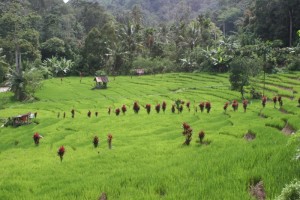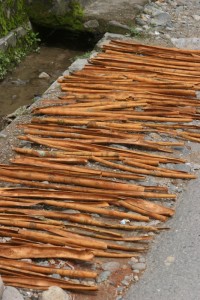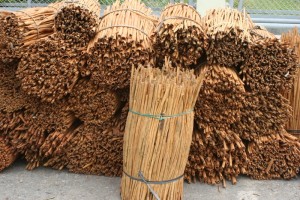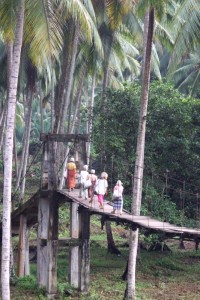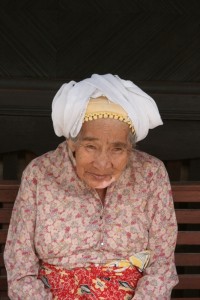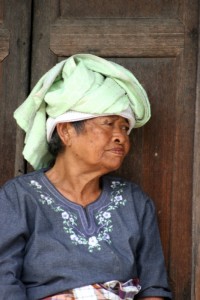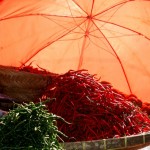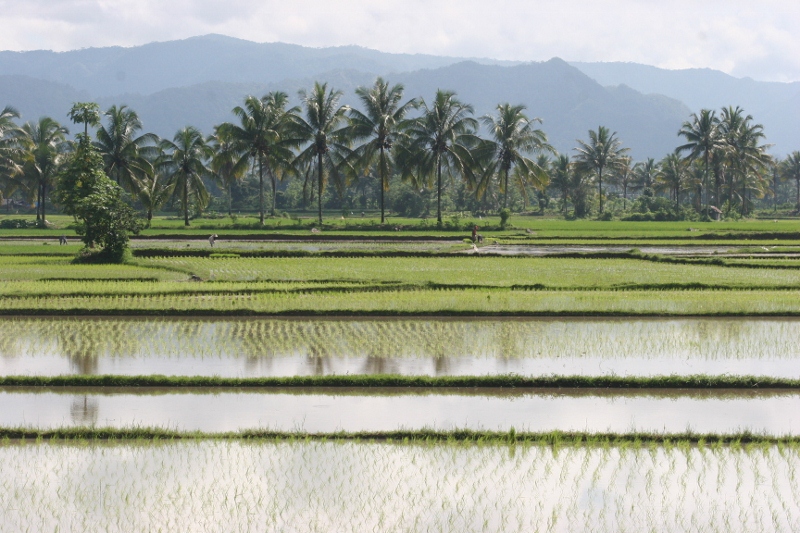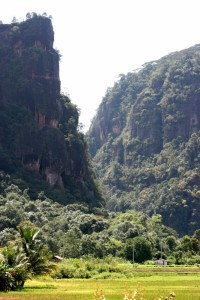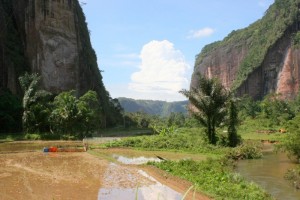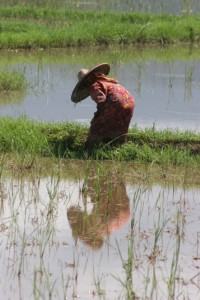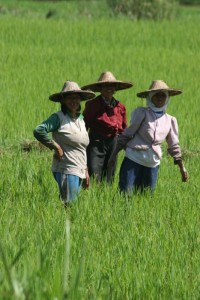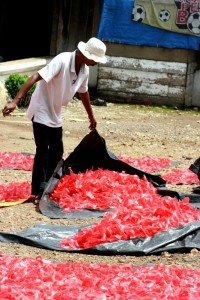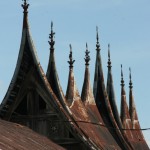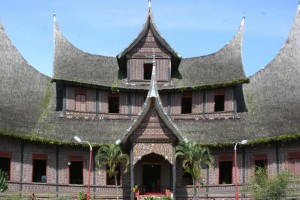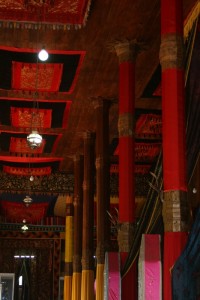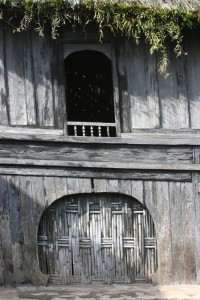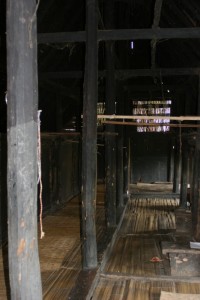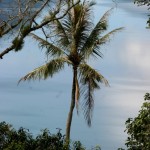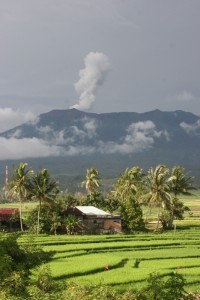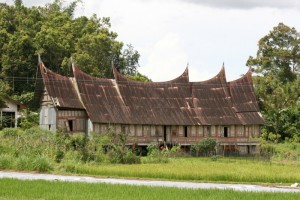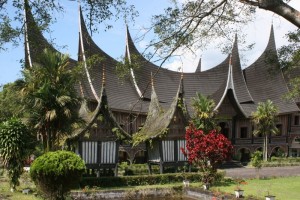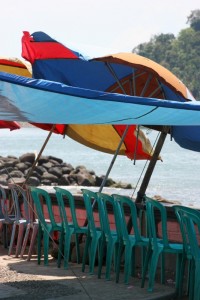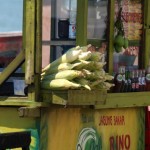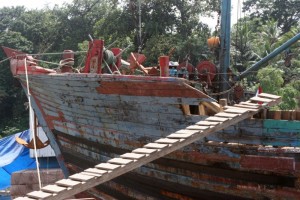Entering Minangkabau country on the way to the hill resort of Bukittinggi, also stopping in the steep Harau Canyon, the traditional village of Sumgayang, and the spectacular Danau Maninjau crater lake, before descending to Padang on the coast
The road to Bukittinggi continued along the Highway, still a two lane affair, past several river valleys, somewhat monotonous scenery. It was cinnamon harvesting time, plants in red, and the large brown hollow sticks being collected. Villages here were more primitive than earlier in Batak country, compact – buildings close to each other -, mainly made up of sturdy wooden houses, not all traditional, but often nicely painted, with shutters and curtains in the windows. Usor Tolang actually had a nice collection of fine Rumah Adats, but foreigners here are obviously the exception, a reason for children to follow you everywhere you go. Even adults thought it more interesting to share my table in the otherwise empty restaurant, just to stare at me, too shy, and perhaps short on English – combined with my lack of Bahasa -, to embark on a conversation.
Bukittinggi is in the heart of Minangkabau country, another Highland people in Sumatra, with their own distinct architecture, already visible from the villages in the approach to town. The houses here have at both sides steeply convex roofs ending in high sky-pointing ends. The town itself is pleasantly relaxed, with a small center, a huge and colourful market, an old Dutch clock tower and Fort de Kock, the old Dutch castle of which not much more than the location, overlooking the town, and the odd canon, remains. I found a delightful hotel recently refurbished – this means unstained carpets, un-chipped bathtub and new towels, although the funds ran out with the replacement of the bed sheets, still full of holes. But I enjoyed the dining room, with comfi-chairs around the tables, and real tablecloths, unheard of in Indonesia but in the poshest hotels. It even had a Western menu, but selecting a steak from here proved a mistake, as it took more than half an hour to prepare, and judging by the taste and tenderness, had been cooking for all this time. I remained the only guest, for three nights, even though this town is supposed to be the weekend resort for the Padang crowd seeking a break from the coastal heat and humidity – which must be truly unbearable, because Bukettinggi, at 930 m altitude, already gets pretty hot.
Exploring the Bukettinggi area proved absolutely fascinating, helped by a bright sunshine. Panorama Point at the southern edge of town provides great views over the surrounding volcanoes, always exciting. Gunung Singgalang is to the SW, and to the SE is Gunung Merapi, not to be confused with the volcano of the same name in Java (but then, Merapi means fire, and G.Merapi is mountain of fire, fair enough that different people find the same name for the same natural phenomenon). In between is the steep Sianok Canyon, quite spectacular. Trying to leave town proved difficult, as I got sidetracked by the market, a huge affair – and have I used the word colourful before? The market was, in fact, so big that I lost my way, and took quite some time to find the car back. I must have circled the market at least three times, and every time I though I had worked out the shortcut, I got lost yet again.
Anyhow, I managed in the end, and we set off for Harau Canyon, through rice paddy countryside. The canyon is very narrow, very steep, very impressive: vertical walls dotted with waterfalls. All the way we encountered the typical local architecture, the Minangkabau houses with the roof spines pointing aggressively upwards, often one house having two or three roofs on top of each other, and sometimes a perpendicular porch with yet another spine or two. Very nice, actually, and similar to what happens in Batak country: the traditional design is also used in new construction, government offices, market halls, or just new houses, thus maintaining the cultural identity – although the corrugated iron has invariably replaced the thatched variety. People must be willing to pay significantly extra for the cost of such identity.
the reconstructed Minangkabau royal palace in Pagaruyung
True to form, the challenge was to find traditional houses, and I got spoiled, completely by surprise, in Sumgayang, where we happened to pass on the way to a, ultimately proving very uninspiring, village with a sacred rock. The rock was useless, but Sumgayang turned out to have rows and rows of traditional houses, with the sky filled with spines, really impressive. Another show of craftsmanship was the replica of the Minangkabau palace in Pagaruyung, an ornately carved and decorated three-story wooden building – and the same neighborhood also supported a few lesser, but equally intricate buildings. The police station in Balusankar, in another old Dutch fort, Fort den Capelle, was a bit of an anticlimax, the ‘fort’ merely being a large, and totally decrepit, house, with two canons in the front for good measure.
Via Balimbing, another village full of traditional houses, including one beautifully restored Rumah Tua – old house -, to Umbilin, at Lake Singkarak, another carter lake: after a while one runs out of new ideas. This one was a lot less impressive than Lake Toba, or than Lake Maninjau would prove the next day. By mid afternoon the sun disappeared behind the clouds, making the landscape a lot less attractive, but providing the background for Mount Merapi, which contributed a decidedly vertical plume from its top contrasting the horizontal grain of the regular clouds.
The gem in West Sumatra must be Lake Maninjau, a smaller crater lake, but most identifiable as such, surrounded by steep volcano walls. The approach, over the crater rim, showed the lake still shrouded in mist, which dissolved slowly on the descent down, through the famous 44 hairpin bends – well, some of them you don’t want to have in your hair, really, but the drive is spectacular enough. The lake shore itself is a fishing industry in itself, with hundreds of platforms to mount nets, and a photographer’s paradise.
On the way to Padang one passes Padangpajang, where there is a library housed in a large traditional building, or replica, well maintained in beautiful gardens. Padang itself is just a few hours away, by car or by special Sunday tourist train, and is a large town, mostly remembered for its beach front with plentiful food stalls and plastic chairs, and its river harbour, where the larger boats are moored. Tried Padang food, which, of course, one can eat everywhere else in Indonesia as well, but I had to have tried it in its place of origin: just a lot of different dishes, mostly fish, most definitely spicy. Strolled the market, the fun fair, and the department store, as everything else of interest was closed on Sundays, and got to the airport for the flight back to Medan and Banda Aceh.

